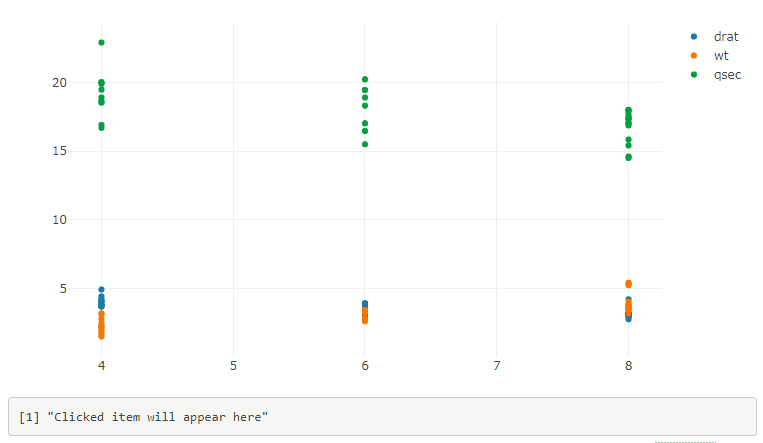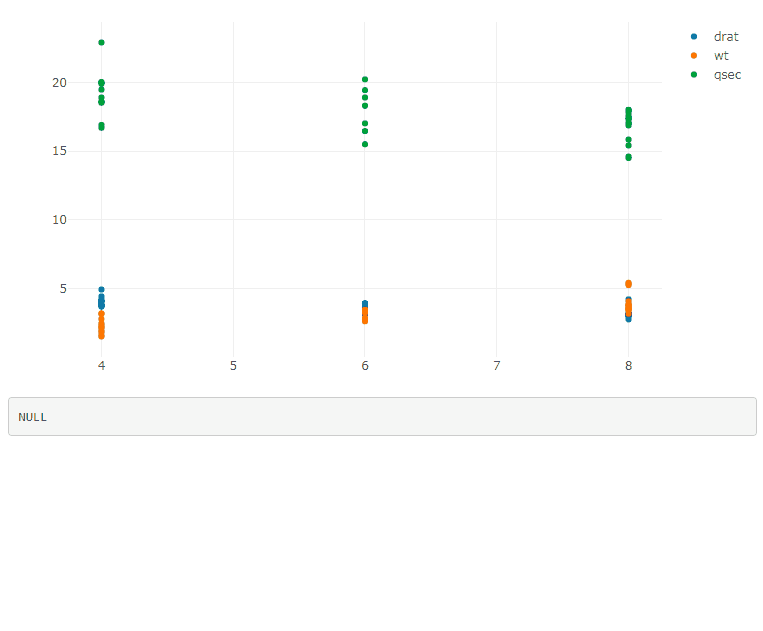Does it help?
library(plotly)
library(shiny)
library(htmlwidgets)
js <- c(
"function(el, x){",
" el.on('plotly_legendclick', function(evtData) {",
" Shiny.setInputValue('trace', evtData.data[evtData.curveNumber].name);",
" });",
" el.on('plotly_restyle', function(evtData) {",
" Shiny.setInputValue('visibility', evtData[0].visible);",
" });",
"}")
ui <- fluidPage(
plotlyOutput("plot"),
verbatimTextOutput("legendItem")
)
server <- function(input, output, session) {
output$plot <- renderPlotly({
p <- plot_ly()
for(name in c("drat", "wt", "qsec"))
{
p = add_markers(p, x = as.numeric(mtcars$cyl), y = as.numeric(mtcars[[name]]), name = name)
}
p %>% onRender(js)
})
output$legendItem <- renderPrint({
trace <- input$trace
ifelse(is.null(trace),
"Clicked item will appear here",
paste0("Clicked: ", trace,
" --- Visibility: ", input$visibility)
)
})
}
shinyApp(ui, server)

EDIT
There's an issue with the previous solution when one double-clicks on a legend item. Here is a better solution:
library(plotly)
library(shiny)
library(htmlwidgets)
js <- c(
"function(el, x){",
" var d3 = Plotly.d3;",
" el.on('plotly_restyle', function(evtData) {",
" var out = {};",
" d3.select('g.legend').selectAll('.traces').each(function(){",
" var trace = d3.select(this)[0][0].__data__[0].trace;",
" out[trace.name] = trace.visible;",
" });",
" Shiny.setInputValue('traces', out);",
" });",
"}")
ui <- fluidPage(
plotlyOutput("plot"),
verbatimTextOutput("legendItem")
)
server <- function(input, output, session) {
output$plot <- renderPlotly({
p <- plot_ly()
for(name in c("drat", "wt", "qsec"))
{
p = add_markers(p, x = as.numeric(mtcars$cyl), y = as.numeric(mtcars[[name]]), name = name)
}
p %>% onRender(js)
})
output$legendItem <- renderPrint({
input$traces
})
}
shinyApp(ui, server)

If you have multiple plots, add the plot id in the legend selector, and use a function to generate the JavaScript code:
js <- function(i) {
c(
"function(el, x){",
" var id = el.getAttribute('id');",
" var d3 = Plotly.d3;",
" el.on('plotly_restyle', function(evtData) {",
" var out = {};",
" d3.select('#' + id + ' g.legend').selectAll('.traces').each(function(){",
" var trace = d3.select(this)[0][0].__data__[0].trace;",
" out[trace.name] = trace.visible;",
" });",
sprintf(" Shiny.setInputValue('traces%d', out);", i),
" });",
"}")
}
Then do p1 %>% onRender(js(1)), p2 %>% onRender(js(2)), ..., and you get the info about the traces visibility in input$traces1, input$traces2, ....
Another way is to pass the desired name in the third argument of the JavaScript function, with the help of the data argument of onRender:
js <- c(
"function(el, x, inputName){",
" var id = el.getAttribute('id');",
" var d3 = Plotly.d3;",
" el.on('plotly_restyle', function(evtData) {",
" var out = {};",
" d3.select('#' + id + ' g.legend').selectAll('.traces').each(function(){",
" var trace = d3.select(this)[0][0].__data__[0].trace;",
" out[trace.name] = trace.visible;",
" });",
" Shiny.setInputValue(inputName, out);",
" });",
"}")
p1 %>% onRender(js, data = "tracesPlot1")
p2 %>% onRender(js, data = "tracesPlot2")
